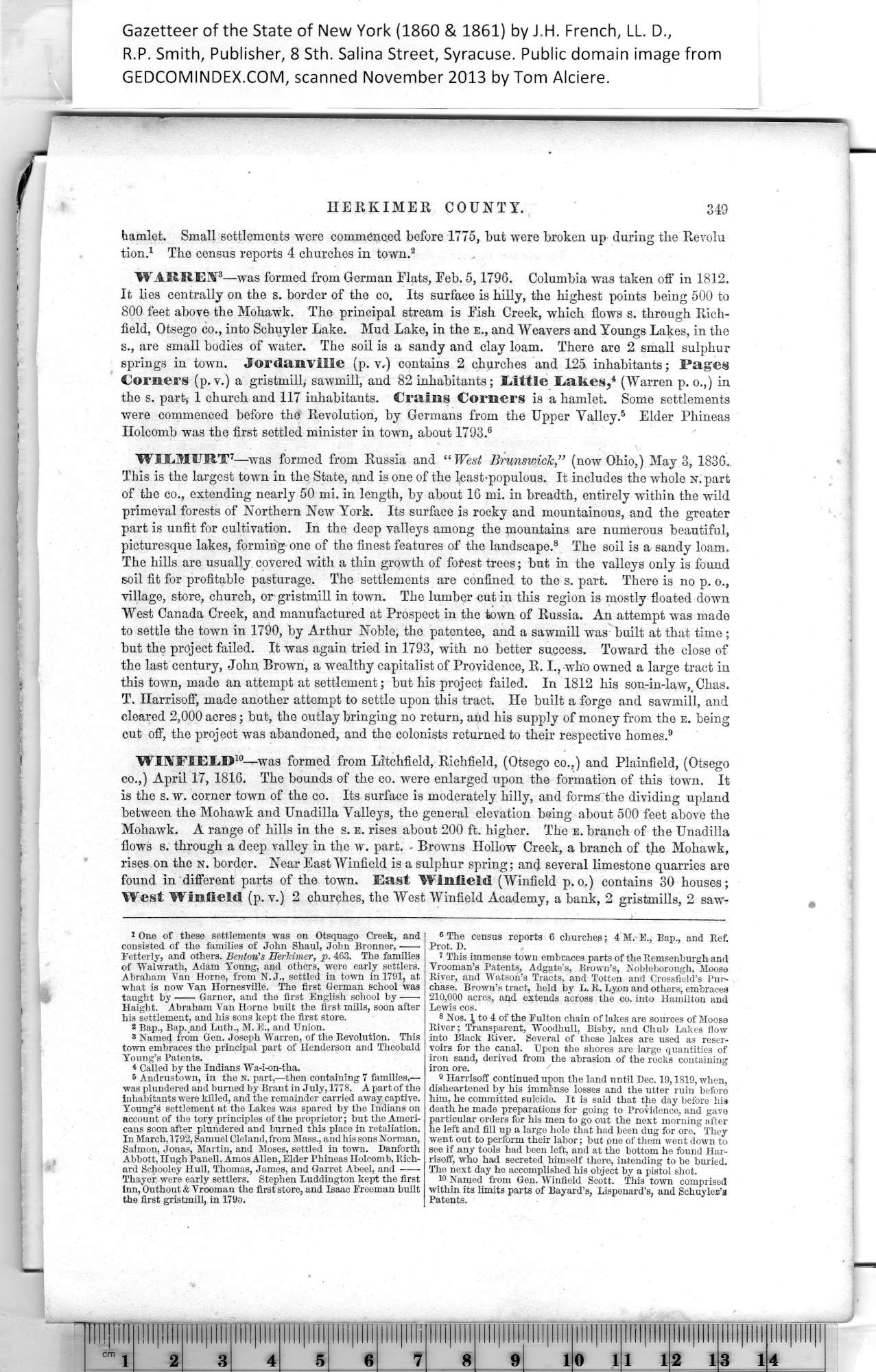|
HERKIMER COUNTY.
hamlet. Small settlements were commenced before 1775, but were broken up during the Revolu
tion.1 The census reports 4 churches in town.2
WARRES3—was formed from German Flats, Eeb. 5,1796. Columbia was taken off in 1812.
It lies centrally on the s. border of the co. Its surface is billy, the highest points being 500 to
800 feet above the Mohawk. The principal stream is Eish Creek, which flows s. through Rich¬
field, Otsego co., into Schuyler Lake. Mud Lake, in the e., and Weavers and Youngs Lakes, in the
s., are small bodies of water. The soil is a sandy and clay loam. There are 2 small sulphur
springs in town. Jordanville (p. v.) contains 2 churches and 125 inhabitants; Pages
Corners (p.v.) a gristmill, sawmill, and 82 inhabitants; Little Lakes,4 (Warren p. o.,) in
the s. part, 1 church and 117 inhabitants. Crains Corners is a hamlet. Some settlements
■were commenced before the Revolution, by Germans from the Upper Yalley.5 Elder Phineas
Holcomb was the first settled minister in town, about 1793.6
WILMCRT7—was formed from Russia and “ West Brunswick,” (now Ohio,) May 3, 1836..
This is the largest town in the State, and is one of the least-populous. It includes the whole n. part
of the co., extending nearly 50 mi. in length, by about 16 mi. in breadth, entirely within the wild
primeval forests of Northern New York. Its surface is rocky and mountainous, and the greater
part is unfit for cultivation. In the deep valleys among the mountains are numerous beautiful,
picturesque lakes, forming one of the finest features of the landscape.8 The soil is a sandy loam.
The hills are usually covered with a thin growth of forest trees; hut in the valleys only is found
soil fit for profitable pasturage. The settlements are confined to the s. part. There is no p. o.,
village, store, church, or gristmill in town. The lumber cut in this region is mostly floated down
West Canada Creek, and manufactured at Prospect in the town of Russia. An attempt was made
to settle the town in 1790, by Arthur Noble, the patentee, and a sawmill was built at that time ;
hut the project failed. It was again tried in 1793, with no better success. Toward the close of
the last century, John Brown, a wealthy capitalist of Providence, R. I., who owned a large tract in
this town, made an attempt at settlement; hut his project failed. In 1812 his son-in-law,. Chas.
T. Harrisoff, made another attempt to settle upon this tract. He built a forge and sawmill, and
cleared 2,000 acres; but, the outlay bringing no return, and his supply of money from the e. being
cut off, the project was abandoned, and the colonists returned to their respective homes.9
WI1VFIELD 10—was formed from Litchfield, Richfield, (Otsego co.,) and Plainfield, (Otsego
co.,) April 17, 1816. The bounds of the co. were enlarged upon the formation of this town. It
is the s. w. corner town of the co. Its surface is moderately hilly, and forms the dividing upland
between the Mohawk and Unadilla Yalleys, the general elevation being about 500 feet above the
Mohawk. A range of hills in the s. e. rises about 200 ft. higher. The e. branch of the Unadilla
flows s. through a deep valley in the w. part. - Browns Hollow Creek, a branch of the Mohawk,
rises on the n. border. Near East Winfield is a sulphur spring; and several limestone quarries are
found in different parts of the town. East Winfield (Winfield p.o.) contains 30 houses;
West Winfield (p. v.) 2 churches, the West Winfield Academy, a hank, 2 gristmills, 2 saw-
|
6 The census reports 6 churches; 4 M. E., Bap., and Ref.
Prot. D. ,,
7 This immense town embraces parts of the Remsenburgh and
Vrooman’s Patents, Adgate’s, Brown’s, Nobleborough, Moose
River, and Watson’s Tracts, and Totten and Crossfield’s Pur¬
chase. Brown’s tract, held by L. R. Lyon and others, embraces
210,000 acres, and extends across the co. into Hamilton and
Lewis cos.
8 Nos. t to 4 of the Fulton chain of lakes are sources of Moose
River; Transparent, Woodhull, Bisby, and Chub Lakes flow
into Black River. Several of these Jakes are used as reser¬
voirs for the canal. Upon the shores are large quantities of
iron sand, derived from the abrasion of the rocks containing
iron ore.
® Harrisoff continued upon the land until Dec. 19,1819, when,
disheartened by his immense losses and the utter ruin before
him, he committed suicide. It is said that the day before his
death he made preparations for going to Providence, and gave
particular orders for his men to go out the next morning after
he left and fill up a large hole that had been dug for ore. They
went out to perform their labor; but one of them went down to
see if any tools had been left, and at the bottom he found Har¬
risoff, who had secreted himself there, intending to he buried.
The next day he accomplished his object by a pistol shot.
to Named from Gen. Winfield Scott. This town comprised
within its limits parts of Bayard’s, Lispenard’s, and Schuyler’s
Patents. |
|
